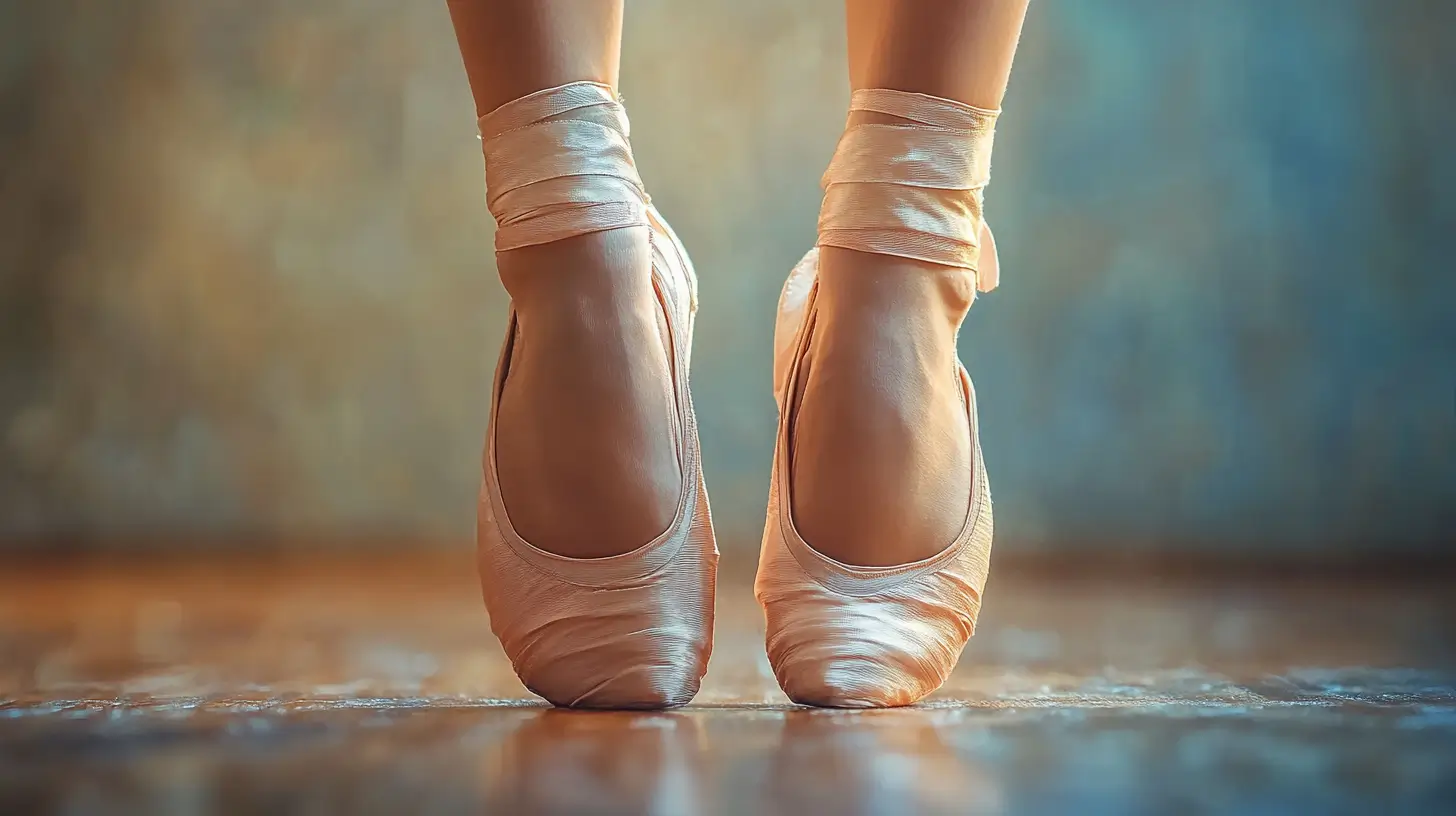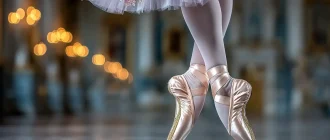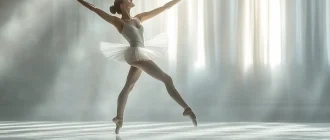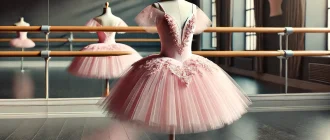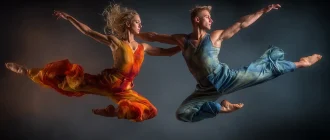Pointe shoes are essential for ballet dancers, enabling them to perform on the tips of their toes. But what are pointe shoes made of? These specialized shoes combine satin, leather, fabric, paper, and cardboard, each critical to ensuring the shoe’s structure and performance and impacting the dancer’s feet.
Key Takeaways
- Pointe shoes are constructed from satin, leather, fabric, paper, and cardboard, each serving specific roles to enhance a dancer’s performance.
- Understanding the anatomy of pointe shoes, such as the box, platform, shank, vamp, and wings, is essential for appreciating their design and functionality in supporting ballet movements.
- Proper fitting and care of pointe shoes are crucial, as they greatly influence their comfort, performance, and longevity.
| Component | Material | Purpose |
|---|---|---|
| Toe Box | Layers of fabric, paper, and glue | It provides support to the dancer’s toes and helps distribute weight evenly. |
| Shank | Leather, plastic, or hardboard | Offers support to the foot’s arch, aiding in maintaining balance and structure. |
| Sole | Leather | It ensures durability and provides friction for stability while dancing. |
| Outer Satin | Satin fabric | It adds aesthetic appeal and ensures a smooth finish for performance under stage lights. |
| Drawstring and Binding | Cotton or elastic | Secures the shoe tightly around the foot for proper fit and comfort. |
| Platform | Hardened layers of the toe box material | It offers a flat surface for dancers to balance en pointe. |
| Ribbon | Satin or nylon | Wraps around the ankle to secure the shoe and prevent slippage during movements. |
| Elastic Bands | Stretchable elastic fabric | It provides additional support and helps keep the shoe snug on the dancer’s foot. |
Key Materials Used in Pointe Shoes

The magic of pointe work lies in the dancer’s skill and the materials that compose these extraordinary shoes. Pointe shoes are made from various materials chosen for their specific properties to support and enhance a dancer’s performance. Contrary to a popular pointe shoe misconception, wood is not a primary material in their construction.
Instead, satin, leather, fabric, paper, and cardboard are used, each contributing to the shoe’s structure and function. These materials and their specific properties make a pointe shoe unique in its ability to support and enhance a dancer’s performance.
Understanding exactly what makes a pointe shoe involves looking at each material in detail. From the sleek satin exterior to the durable leather sole and the supportive layers of fabric, paper, and cardboard, each shoe part is meticulously crafted to ensure the dancer can balance and perform pointe work precisely.
Satin
Satin is the primary material used for the exterior of pointe shoes, providing a sleek and stylish appearance. This material is chosen not only for its aesthetic appeal but also for its smooth and luxurious texture that enhances the overall look of the dancer’s foot. The satin covering contributes to the visual elegance of the shoes, making them a staple in ballet performances.
Moreover, satin’s smooth surface allows for adding a circular drawstring elastic running throughout the shoe, which helps adjust the fit around the dancer’s foot. This combination of satin and drawstring elastic ensures that the shoe fits snugly, like a second skin, providing comfort and functionality.
Leather
Leather is another essential material for constructing pointe shoes, particularly for the outer sole. Using leather for the sole enhances the shoe’s durability, providing a sturdy base that can withstand the rigors of dancing en pointe. This material ensures the shoe remains intact and functional through numerous performances and practice sessions.
Additionally, leather offers excellent grip on the dance surface, which is vital for a dancer’s performance. The leather outer sole helps prevent slips and falls, allowing the dancer to focus on their movements confidently. This combination of durability and grip makes leather an indispensable part of the shoe’s design.
Fabric, Paper, and Cardboard
The internal structure of a pointe shoe relies heavily on layers of fabric, paper, and cardboard, which are hardened by glue to provide the necessary support and stability. These materials are packed together to form a strong yet flexible shoe that can adapt to the dancer’s foot movements. Combining these materials ensures the shoe maintains its shape and offers the support needed for pointe work.
Fabric is typically used for the outer covering, while layers of paper and cardboard are essential for creating the internal structure and shape of the shoe. This intricate construction process results in a durable pointe shoe that can withstand the demands of ballet dancing and provide comfort and support to the dancer.
Anatomy of a Pointe Shoe
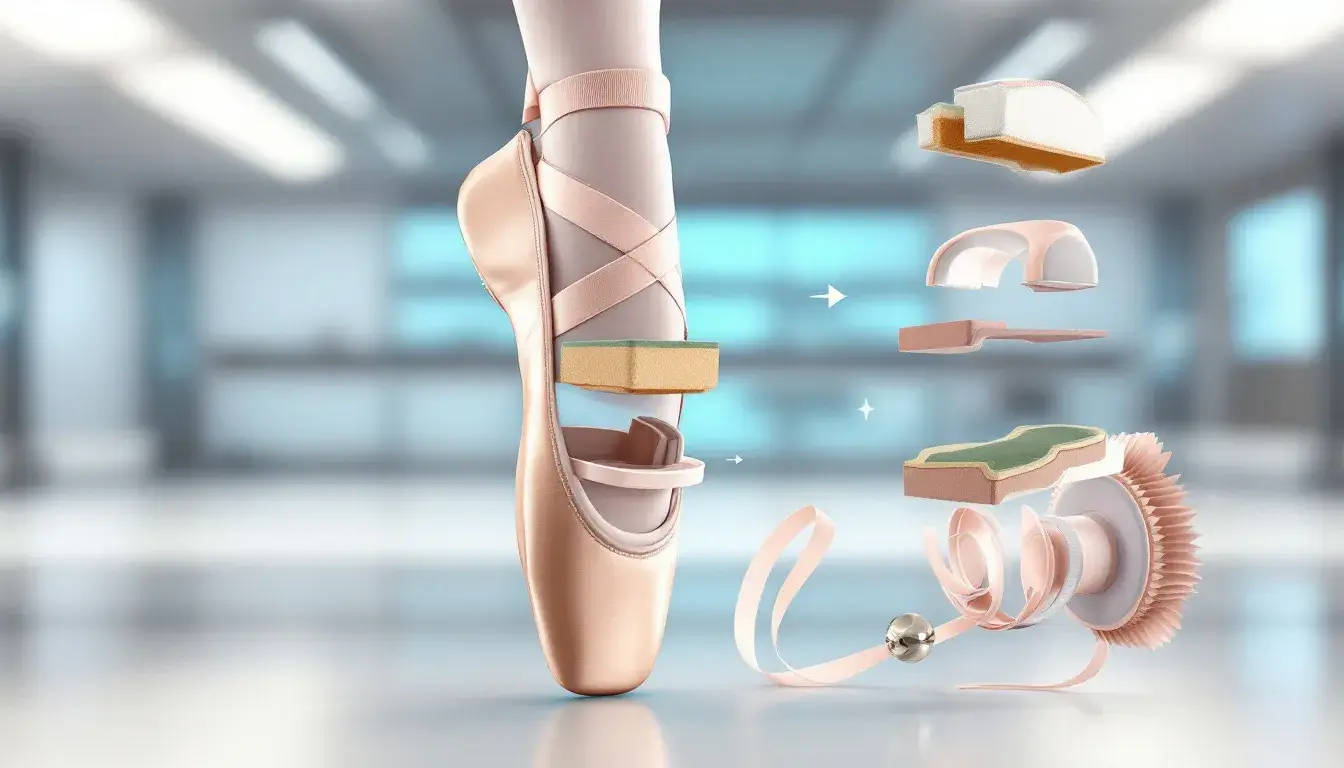
Understanding the anatomy of pointe shoes helps to appreciate their complexity. Each part of the shoe works harmoniously to support the dancer’s foot and enable the precise movements required for ballet. The key components, or parts of a pointe, include the box, platform, shank, vamp, and wings, each with a specific role in the shoe’s overall function.
The shoe’s design balances support and flexibility. Its use of materials like fabric, paper, and cardboard, combined with precise construction, allows it to meet the physical demands of pointe work while maintaining rigidity and comfort.
Each part of the shoe contributes uniquely to its overall function.
Box and Platform
The box of a pointe shoe is perhaps the most crucial component, as it encases the toes and provides a rigid structure at the front of the shoe. Made from multiple layers of fabric, cardboard, and paper, the toe box is reinforced with adhesives to ensure durability and support. This construction allows the dancer to balance on the tips of their toes while performing en pointe.
The platform, located at the tip of the box, provides a stable area for the dancer to balance. This flat surface maintains stability during pointe work and allows for precise movements and poses. Together, the box and platform form the foundation of the shoe’s support system, enabling the dancer to perform confidently and gracefully.
Shank
The shank is vital to the shoe’s anatomy, supporting the dancer’s arch. Typically made from leather and composite materials, the shank is incorporated into the shoe’s sole, helping to maintain its shape and offering stability. This rigid support structure ensures the shoe can withstand the pressures of pointe work.
The shank supports the arch of the dancer’s foot, allowing for more efficient weight transfer and better balance. Without a properly constructed shank, the shoe would lack the necessary rigidity, making it difficult for the dancer to perform en pointe. This component is integral to the pointe shoe’s overall functionality.
Vamp and Wings
The vamp of a pointe shoe covers the top of the foot, helping to secure the dancer’s foot within the shoe. This shoe part is designed to hug the foot closely, providing comfort and stability. The symmetrical sides of the vamp are directed toward the heel, ensuring a snug fit that enhances the dancer’s control over their movements.
Wings, on the other hand, provide additional support on the sides of the shoe, aiding in maintaining proper alignment during movements. Together with the vamp, the wings help to distribute pressure evenly across the foot, reducing the risk of injury and improving overall performance.
This combination of vamp and wings is essential for a well-fitting and supportive pointe shoe.
The Manufacturing Process
Creating a pair of pointe shoes is a meticulous and skill-intensive process. The traditional method is the turn shoe method, where the shoe is assembled inside out on a form before being turned right side out for finishing. This technique requires great precision and craftsmanship, resulting in slight variations among the same models.
The manufacturing process combines materials and techniques to ensure the shoe meets each dancer’s needs. From cutting leather for the sole to sewing satin for the exterior, each step is performed carefully to create a functional and beautiful shoe.
Let’s explore the turn shoe method and the importance of breaking in pointe shoes.
Turn shoe Method
The turn shoe method is a traditional technique where the shoe is assembled inside out on a form and then turned right side out for finishing. This allows for precise construction, ensuring each part fits together seamlessly and provides essential support.
While a common last is often used for both shoes, custom can be created for individual dancers, ensuring a perfect fit that enhances comfort and performance.
The turn shoe method demonstrates the skill and craftsmanship required to produce high-quality pointe shoes.
Breaking In
Breaking into new pointe shoes is crucial for comfort and fit. To expedite this process, dancers often manipulate their shoes by gently crushing the box and exercising in demi-pointe shoes.
Proper fitting can make pointe shoes comfortable without extensive pre-wear. The boots usually take two to three classes for beginners to mold to their feet. Fitting pointe shoes helps dancers adapt their boots to their unique foot shapes, improving performance and reducing injury risk.
Popular Pointe Shoe Misconceptions
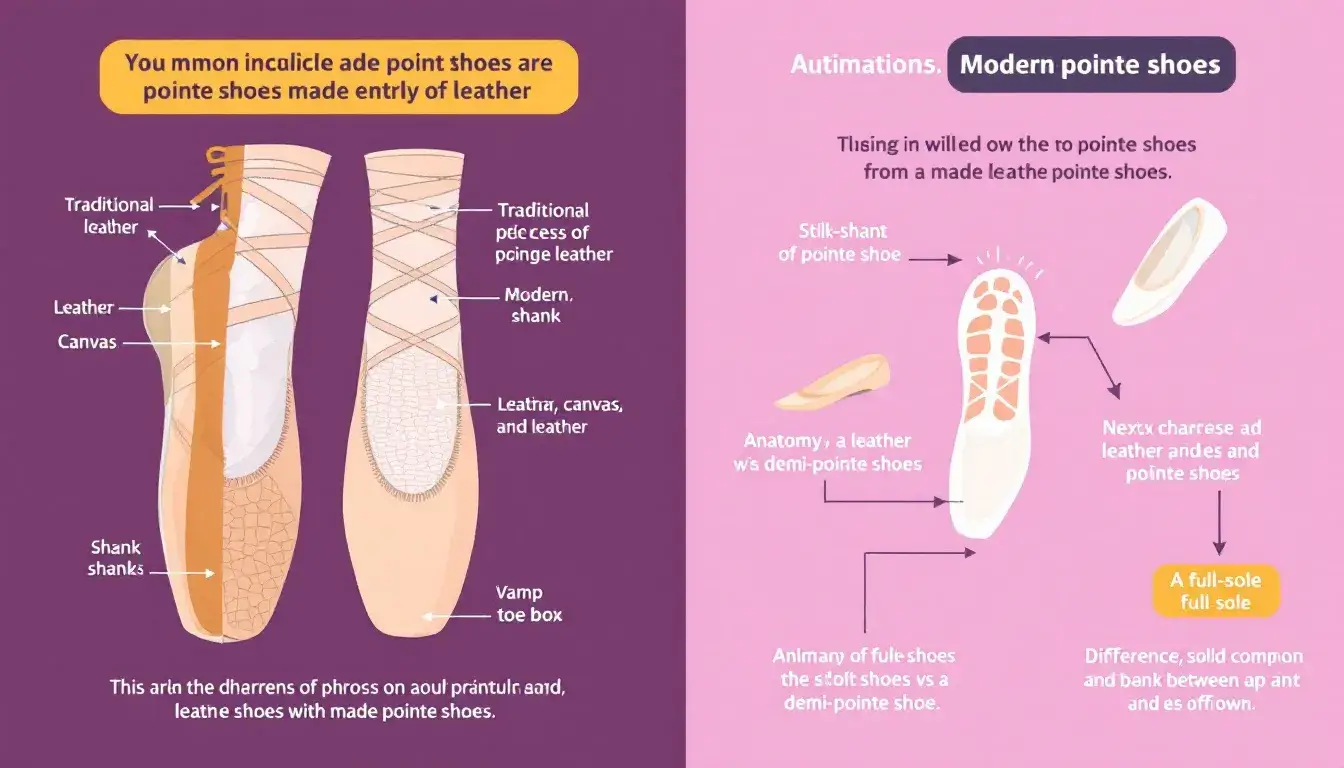
Despite the beauty and elegance of pointe shoes, many misconceptions surround their use and construction. One popular pointe shoe misconception is that wearing them will deform your feet. Properly fitted shoes can accommodate different foot types without causing deformities. It’s crucial to have pointe shoes professionally fitted to ensure they suit the unique shape of each dancer’s feet and maintain foot health.
Dispelling these myths is important for dancers and ballet enthusiasts. Understanding the correct materials and fitting requirements helps dancers make informed choices to enhance performance and protect their feet. Here are some common misconceptions.
Material Myths
A common misconception is that wood is the primary material used to create pointe shoes. Instead, durable and supportive shoes are made from satin, leather, fabric, paper, and cardboard. Understanding the correct materials helps dancers make informed choices and avoid misinformation.
Misconceptions about the materials in pointe shoes can be confusing. By debunking these myths, we clarify what makes a pointe shoe and how its construction supports a dancer’s movements.
Fitting Myths
Another common myth is that dancers must be a specific age to wear pointe shoes. While age can influence when a dancer starts pointe work, it’s more about physical maturity and control than a particular age requirement. Proper fitting and physical readiness are crucial for beginning to work safely.
Debunking popular pointe fitting myths ensures dancers approach pointe work with the right knowledge and preparation. Emphasizing physical maturity and control over age allows dancers to begin their pointe journey safely and effectively.
Choosing the Right Pointe Shoe Brand

Choosing the right pointe shoe brand is vital for optimal support, comfort, and performance. A professional fitting identifies a dancer’s unique foot needs and aids in selecting the right shoe from the many available brands. Various brands offer models tailored to specific foot shapes and preferences.
Knowing the available options and the significance of a proper fit can greatly impact a dancer’s performance and comfort. Here’s a look at professional fitting and popular pointe shoe brands worldwide.
Professional Fitting
A professional fitting considers foot shape, strength, and the dancer’s foot goals to find the most suitable pointe shoe fitting. These sessions ensure the shoe design aligns with the dancer’s specific foot characteristics, providing support and comfort.
Professional dancers often modify their shoes for the perfect fit, highlighting the importance of precision in the fitting process. Professional fittings help enhance a dancer’s feet, improve performance, and reduce injury risk.
Popular Brands
Several pointe shoe brands are favored by dancers globally for their quality and variety. Brands like Nikolay, Bloch, Suffolk, and Gaynor Minden offer a range of models tailored to specific foot shapes and preferences. Each brand has unique features that contribute to a pointe shoe’s exceptional performance and comfort.
For example, Gaynor Minden is known for its comfort and durability due to its unique elastomeric materials. Bloch offers diverse styles catering to various foot shapes, emphasizing durability and comfort in their pointe shoes.
Familiarity with these brands and their offerings aids dancers in making informed decisions when selecting pointe shoes.
Caring for Your Pointe Shoes
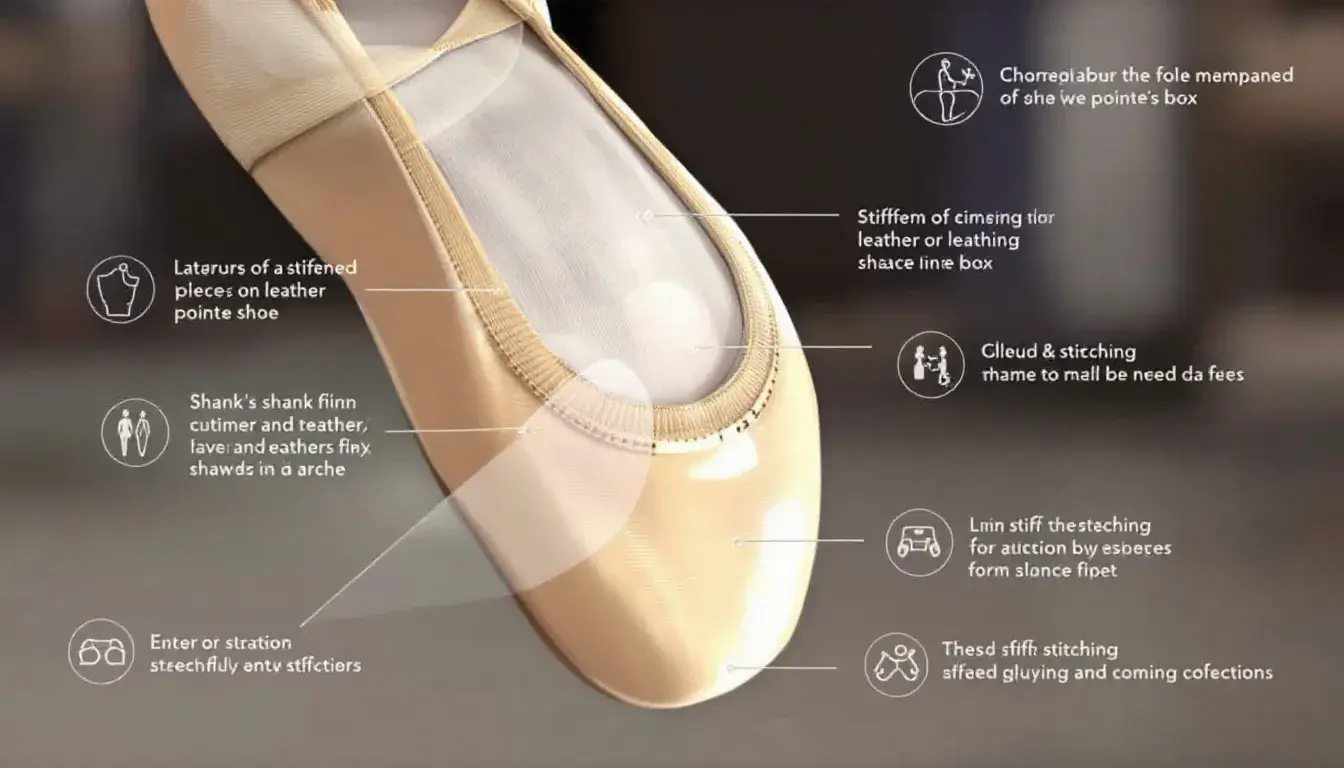
Proper pointe shoe care extends their lifespan and maintains performance. It is crucial to allow them to dry after use, as moisture weakens the shank. Thorough drying and adequate storage preserve the shoe’s materials and shape.
Following recommended care practices keeps pointe shoes supportive and comfortable for longer. Here are the best practices for storing and cleaning pointe shoes.
Proper Storage
Proper storage maintains the shape and prolongs the usability of pointe shoes. Keep ballet shoes in a clean, dry bag or container to protect them from moisture and dust. Store them in a way that prevents compression or twisting to retain their original shape. A breathable bag or pouch helps avoid moisture accumulation, which can weaken the materials.
Avoid tightly enclosed spaces to prevent odor and premature softening. Instead of using heat sources like radiators, always air-dry pointe shoes completely after use.
Following these storage tips helps keep pointe shoes in optimal condition for the next performance.
Cleaning Tips
Cleaning pointe shoes regularly preserves their appearance and functionality. Use a damp cloth to remove dirt and sweat, and let the boots dry naturally, away from direct sunlight, to prevent material damage.
Store pointe shoes in a breathable bag or box to prevent excess moisture and protect them from dust. Washing is not advisable; cosmetic techniques like shoe paint are used to manage scuff marks.
Following these cleaning tips helps dancers maintain the integrity and appearance of their pointe shoes.
Summary
In summary, the construction and care of pointe shoes are intricate processes involving various materials and techniques. Each component, from the sleek satin exterior to the durable leather sole and supportive layers of fabric, paper, and cardboard, is crucial in ensuring the shoes’ performance and longevity.
Understanding the anatomy of a pointe shoe and the manufacturing process helps us appreciate the craftsmanship and precision involved.
Debunking popular misconceptions about pointe shoes and emphasizing the importance of proper fitting and care can significantly enhance a dancer’s experience. By choosing the right pointe shoe brand and following recommended care practices, dancers can ensure their shoes remain supportive, comfortable, and ready for the demands of ballet.
Remember, the journey of dancing en pointe is as much about the shoes as it is about the dancer’s skill and dedication.
Frequently Asked Questions
What materials are used to make pointe shoes?
Pointe shoes are typically constructed from satin, leather, fabric, paper, and cardboard, each contributing to the shoe’s overall structure and performance. Understanding these materials is essential for appreciating the craftsmanship behind pointe shoes.
Do pointe shoes deform your feet?
Properly fitted pointe shoes do not deform your feet; they should be professionally fitted to match the unique shape of each dancer’s feet and support foot health. Adequate fitting is essential to prevent any potential issues.
How long does breaking in a new pair of pointe shoes take?
For beginners, breaking in a new pair of pointe shoes typically takes two to three classes, during which the boots begin to mold to their feet. Ensuring a proper fit can enhance comfort without the need for extensive pre-wear.
What is the turnshoe method?
The turn shoe method is a traditional technique for creating pointe shoes. In this method, the shoe is initially assembled inside out on a form and then turned right for final adjustments. This method ensures the boots maintain their structure and fit properly.
How should I store my pointe shoes to prolong their lifespan?
To prolong the lifespan of your pointe shoes, store them in a clean, dry, and breathable bag or container, ensuring they air dry completely after use. Avoid placing them in tightly enclosed spaces to prevent moisture buildup.
How do I know if my pointe shoes fit correctly?
Properly fitting pointe shoes should feel snug but not painful. Your toes should be flat and not curled, with minimal space at the heel. When standing en pointe, the shoe should support your foot without causing discomfort or excessive pressure.
What is the difference between full shank and 3/4 shank pointe shoes?
Full shank pointe shoes provide support along the entire length of the sole, offering maximum stability. In contrast, 3/4 shank shoes have a shortened support structure, allowing greater flexibility and easier roll-through during movements.
How often should I replace my pointe shoes?
The lifespan of pointe shoes varies based on usage and intensity. Professional dancers may need to replace them after a single performance, while students might find them lasting several weeks to months. Signs of wear include softened boxes, broken shanks, and lack of support.
Can I clean my pointe shoes?
You can gently clean pointe shoes using a slightly damp cloth to remove surface dirt. A mixture of baking soda and water applied with a soft brush can be effective for tougher stains. Avoid soaking the shoes, as excessive moisture can damage their structure.
What are toe pads, and do I need them?
Toe pads are cushioning inserts made from gel, foam, or fabric, placed inside pointe shoes to protect toes from friction and pressure. While not mandatory, many dancers use them to enhance comfort during practice and performance.
How should I break in new pointe shoes?
Breaking in pointe shoes involves gently molding them to your feet. This can be done by performing relevés and pliés at the barre, allowing the shoes to adapt to your movements. Avoid excessive bending or force, which can compromise the shoe’s integrity.
Is there a difference between pointe shoes for beginners and professionals?
Yes, beginner pointe shoes often have softer shanks and more support to develop strength and technique. Professional-level shoes may offer more flexibility and responsiveness, catering to advanced dancers’ needs.
What is the purpose of ribbons and elastics on pointe shoes?
Ribbons and elastics secure the pointe shoes to the dancer’s feet, providing stability and preventing slippage during movements. Proper placement and tension are crucial for both safety and performance quality.
Can pointe shoes be customized for individual foot shapes?
Many manufacturers offer customization options, including varying widths, vamp lengths, and shank strengths, to accommodate different foot shapes and preferences. A professional fitting can help determine the best specifications for your needs.
How do I store my pointe shoes to prolong their lifespan?
After use, allow pointe shoes to air dry completely, away from direct heat or sunlight. Storing them in a breathable bag helps prevent moisture buildup, which can degrade the materials. Avoid leaving them in damp or enclosed spaces.
What is the difference between satin and canvas pointe shoes?
Satin pointe shoes are traditional and offer a smooth, glossy finish preferred for performances. Canvas shoes are more durable and may be used for practice sessions. The choice depends on personal preference and specific use cases.
Are there vegan-friendly pointe shoes available?
Some brands offer pointe shoes made without animal-derived materials, catering to vegan dancers. These alternatives use synthetic materials for the shoe components, providing similar performance characteristics.
How do I know when my pointe shoes are “dead”?
A pointe shoe is considered “dead” when it no longer provides adequate support, often due to a softened box or broken shank. Signs include difficulty maintaining balance and a lack of resistance during movements.
Can I use the same pair of pointe shoes for different dance styles?
Pointe shoes are specifically designed for ballet and en pointe work. Using them for other dance styles can lead to improper support and increased risk of injury. It’s advisable to use footwear that is appropriate for each dance discipline.
What are the signs of an ill-fitting pointe shoe?
Indicators include excessive pressure on the toes, slipping heels, lack of support, and movement discomfort. An ill-fitting shoe can hinder performance and increase the risk of injury, emphasizing the importance of proper fitting.
Is it normal for pointe shoes to make noise during dancing?
Some noise is typical due to the materials and construction of pointe shoes. However, excessive noise can be minimized through proper technique and, in some cases, by choosing shoes designed for quieter performance.
How do I prevent blisters and calluses from pointe work?
Preventative measures include using toe pads, ensuring proper shoe fit, and gradually increasing pointe work intensity. Maintaining foot hygiene and promptly addressing discomfort can also help reduce the risk of blisters and calluses.
Can I dye my pointe shoes to match my skin tone or costume?
Pointe shoes can be dyed using fabric dyes or markers to match skin tones or costumes. Testing the dye on a small area first and allowing the shoes to dry completely before use is important.
What is the role of the shank in a pointe shoe?
The shank is a supportive structure within the sole of the pointe shoe, providing the necessary stiffness to support the arch and facilitate en pointe movements. Shank strength varies to accommodate different levels of foot strength and flexibility.
Are there pointe shoes designed for dancers with specific foot conditions?
Some pointe shoes are tailored to address specific foot conditions, such as high arches or bunions. Consulting with a professional fitter or podiatrist can help identify suitable options for support and comfort.

